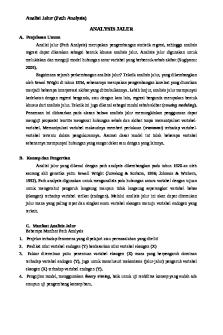Quiz for LM3 critical path analysis PDF

| Title | Quiz for LM3 critical path analysis |
|---|---|
| Author | 婕 季 |
| Course | Project Management |
| Institution | University of Bristol |
| Pages | 5 |
| File Size | 349 KB |
| File Type | |
| Total Downloads | 37 |
| Total Views | 136 |
Summary
Quiz...
Description
1. Calculate the remaining values for the activities shown in the figure. To do this, first perform a forward then a reverse path. Then fill in the blanks:
For Activity J, the Earliest Start is 23. For Activity J, the Earliest Finish is 28 For Activity J, is the total float is 0 For Activity C, the Latest Finish is 21 For Activity C, the Latest Start is 16 For Activity C, is the total float is 6
解析:
2. Which of the following is the critical path for this figure?(同上图) Start-A-C-F-J-Finish Start-A-B-D-J-F-C-A-Start Start-A-B-D-J-Finish Start-A-C-F-J-D-B-A-Start 3. Study the network shown in the figure. All values are shown correctly. If Activity C took 3 days longer than expected, what would be the effect on the whole project? A.
There is insufficient information to answer
B.
There would be no effect on the project
C.
The project would be delayed by 6 days
D. E. 解析:
The project would be delayed by 3 days
4. Study the network shown in the figure. If Activity C is delayed by 2 days and Activity F is delayed by 4 days, which ONE of the following statements is TRUE? (同上图) A.
The project would be delayed by 6 days
B.
The project would be delayed by 2 days
C.
The project would not be delayed, but a new critical path is created
D.
The project would be delayed by 4 days
Correct. The project would not be delayed. The float for these activities is 6 days. This is the total float for the path A-C-F-J. This mans that a total delay of up to and including 6 days is possible without delaying the project. In other words, any combination of delays to C and F that totals 6 or less would not delay the project. But this does reduce the float for these activities to 0, meaning a second critical path is created, as shown. See the full solution in the figure.(同上题解析图)
5. Study the extract from the network diagram shown in the figure. What is the Earliest Start for Activity D? A.
75
B.
60
C. There is information to answer D.
insufficient
55
Correct. The answer is 60. The two activities that precede D are Activity B and Activity C. Their Earliest Finish dates determine how early D can start, i.e., the greater of 55 and 60. See the full solution in the figure. 解析:
6. Study the extract from the network diagram shown in the figure. What is the Earliest Start for Activity J? (同上图) A. 75 B.
90
C.
There is insufficient information to answer
Correct. There is insufficient information. We are not shown all the activities that precede J. The Earliest Finish dates of these activities will determine the earliest that J can start. We only know one of the values, from Activity D (= 75). From this we know that J must start at least on day 75, but it could be later than that, depending on the Earliest Finish dates of the other preceding activity indicated. See the full solution in the figure(同上题解析图)
7. Study the extract from the network diagram shown in the figure. What is the Earliest Start for Activity D?
55
Correct. The answer is 55. We are given all the preceding activities to D, and we can compute the Earliest Finish dates for each of these, which are: B=45, C=55, J=50. This means D can start no earlier than on day 55. Note that we can also compute the Earliest Start times for Activities H and K, as well as their Earliest Finish dates. But we are not given their succeeding activities, so we cannot compute Latest Start and Finish times for H. We can for K, though, because we are told that it is in the critical path (i.e., its float = 0, so ES = LS and EF = LF). See the full solution in the figure.
解析:
8. Study the extract from the network diagram shown in the figure ( 同 上 图 ) . What is the Latest Start for Activity J?
45
Correct. Because we are given that D is in the critical path, we know its Latest Finish and Latest Start dates: 80 and 55). This means we can compute the Latest Finish dates of activities that precede D (they must finish by D’s Latest Start), which must be 55. This means J’s Latest Start = 55 – its duration of 10 = 45. See the full solution in the figure. (同上题解 析图)...
Similar Free PDFs

The Critical Path
- 1 Pages

Critical path method
- 4 Pages

Critical Analysis
- 6 Pages

Old Path White Clouds Analysis
- 10 Pages

5.10 Critical Analysis
- 5 Pages

Critical Analysis Draft
- 6 Pages

Critical Analysis Essay Outline
- 2 Pages

Critical analysis of FLorence
- 4 Pages

Critical Analysis of Frozen
- 16 Pages
Popular Institutions
- Tinajero National High School - Annex
- Politeknik Caltex Riau
- Yokohama City University
- SGT University
- University of Al-Qadisiyah
- Divine Word College of Vigan
- Techniek College Rotterdam
- Universidade de Santiago
- Universiti Teknologi MARA Cawangan Johor Kampus Pasir Gudang
- Poltekkes Kemenkes Yogyakarta
- Baguio City National High School
- Colegio san marcos
- preparatoria uno
- Centro de Bachillerato Tecnológico Industrial y de Servicios No. 107
- Dalian Maritime University
- Quang Trung Secondary School
- Colegio Tecnológico en Informática
- Corporación Regional de Educación Superior
- Grupo CEDVA
- Dar Al Uloom University
- Centro de Estudios Preuniversitarios de la Universidad Nacional de Ingeniería
- 上智大学
- Aakash International School, Nuna Majara
- San Felipe Neri Catholic School
- Kang Chiao International School - New Taipei City
- Misamis Occidental National High School
- Institución Educativa Escuela Normal Juan Ladrilleros
- Kolehiyo ng Pantukan
- Batanes State College
- Instituto Continental
- Sekolah Menengah Kejuruan Kesehatan Kaltara (Tarakan)
- Colegio de La Inmaculada Concepcion - Cebu






